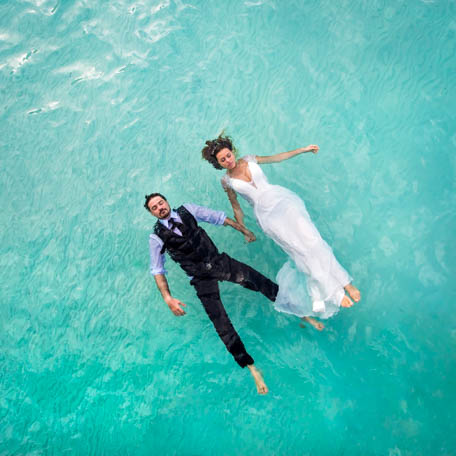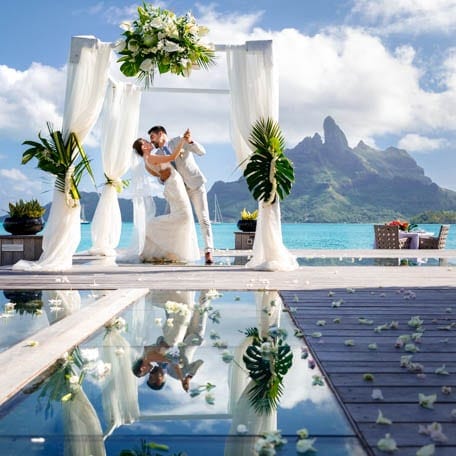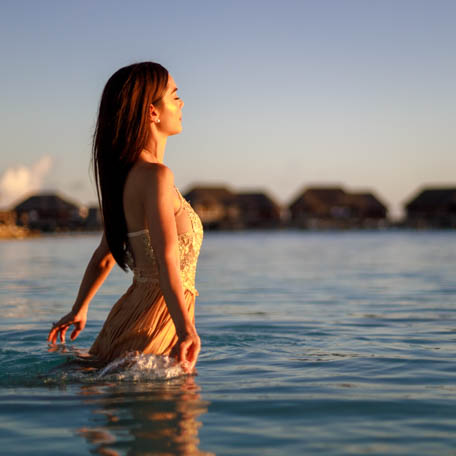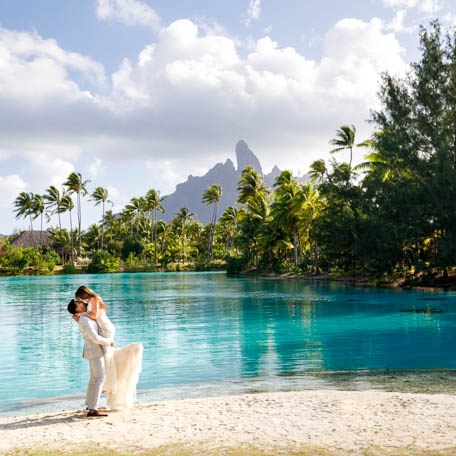Everything you need to know about the traditional Polynesian wedding ceremony in Bora Bora
Polynesian wedding ceremony is beautiful but especially when you know the symbols and traditions behind it.
The Polynesian Wedding ceremony held in all the Tahitian islands is a merely folkloric celebration. It includes a Tahitian priest or Tahua, a conch blower, musicians and dancers, a handfasting blessing ceremony, exchange of flowers crowns and leis and being wrapped in a Tifafai or quilt.
Bora Bora is a magical and romantic place to celebrate your love. The pristine lagoon, the peak of Mount Otemanu and the awe-inspiring sunsets will take your breath away while the traditional customs will lend meaning and emotion to your ceremony.
Why should I have a Polynesian wedding ceremony?
So you got married with all your family and friends, you had a great time spending hours kissing all your cousins, hugging all you aunties, but the day past so fast and you felt so rushed that you kinda missed that intimacy and romance in a way that you imagined.
If you always have dream about toes in sand, one-of-a-kind backdrop, tropical flowers, dancers and music in a ceremony full of symbols and traditions the Polynesian Wedding is for you.
“I want to be a simple bride when I get married. I want a beach wedding where I am running around on the sand in a white dress. “
– Sonakshi Sinha
Where is the Polynesian Wedding ceremony held?
Depending the resort, you have different options. Your weeding planner will help you to choose the best one for you.
Amongst the available options, barefoot in the beach is one of the favorites (so romantic !)
Most resorts also offer a chapel if you are looking for a more symbolic ceremony. However, keep in mind that from a photographic point of view, the space is very limited, reducing the possibilities for more powerfull pictures. Finally, the light is much harder to control.
What should I wear during the Polynesian wedding ceremony?
Traditionally, the bride and groom wear a white pareo (Tahitian name to describe a piece of cloth worn wrapped around the body). Women will usually wrap it around their upper body, covering it from breasts to above the knees. Either they rely on their breasts for it not to slide down, or they may wrap a corner around their shoulder or their neck. In more traditional surroundings the covering of the upper body is less important, but the covering of the thighs is. Then it is worn as a longer skirt. Men wear it as a short skirt.
Althought nowadays lots of couples prefer to wear classical western wedding outfits.
And of course there is no bride without a bouquet made with fresh polynesian flowers.
Stages of the Polynesian Wedding Ceremony
The priest will be dressed in flowing robe (often in shades of red or yellow. Sometimes dramatic black) and a striking feathered headdress. He will conduct the ceremony in Tahitian and English.
The arrival in outrigger canoe
When the ceremony is at the beach, an outrigger canoe or va’a paddled by a bare-chested Tahitian man in pareo transports the bride to the wedding location, but sometimes it can be the groom or both, depending on the resort.
Traditionally, the groom awaits his bride on a secluded beach or islet. Upon arrival, the bride meets her groom and they get escorted into a circle or heart of flowers and leaves, then the Polynesian wedding ceremony begins.
Heart of Flowers and Pomare chairs
A heart-shaped design of flowers and palm threes leaves is used for the couple to stand together as they exchange vows, rings, and leis. This tropical circle symbolises a ring of love surrounding the couple.
During the Polynesian wedding ceremony, the couple will be sitting in a traditional “armchair Pomare” made with an intricate woven rattan design . The origin of the name comes from the last royal dynasty of Tahiti. According to the legend, Prince Hinoi (Teri’ihinoiatua Pomare would have died in this chair.). It is said that the Prince Hinoi was measuring 2 meters for 250 kilos, so you can imagine that this chair will be solid in any event.
It was in 1974, the armchair has a a reappearance in the famous erotic film “Emmanuelle”. We find the main actress slightly undressed, in a pose suggesting all the fantasies in this famous armchair “Pomare”.
Blowing of the Conch Shell
Before the ceremony starts, the conch blower will sound the conch shell or Pu in all directions in an effort to summon the Gods to be present at the wedding and all the Mana (power and energy).
This long, deep call of the pu is also believed to summon the land, air, fire, and sea to be witnesses to the ceremony.
It signals that something significant is about to occur, and is usually the sign for the bride to start walking down the aisle.
Hand-fasting blessing
The priest will start by blessing you with sacred Auti leaves, cordyline fruticosa, a member of the lily family. From ancient up to this day the leaves of the Auti plant have been used for spiritual protection, purification and healing. In old times, only the royalty and high priests were allowed to wear Auti leaves during their ceremonial rituals to ward off evil spirits and invoke the blessings of the gods.
The priest will divide one Auti leaf making two bracelets and he will put them around your wrists to tie the knot, rather like the hand-fasting ceremony but with a local twist! You can tie the knotted leaves to the outside of our bungalow door when you returned which means ‘private’, do not disturb! 😉
With the hands bound together you will get blessed and your sins washed away with pure water from the lagoon or with fresh coconut water.
Getting “Lei’d”
You’ve probably heard the joke about people getting “lei’d”, right?
The bride and groom will exchange Leis and Flower Crowns. In French Polynesia a Lei is given at every joyous occasion and certainly in the celebration of a wedding, the Lei represents the Joy of Life. Like a wedding ring, the Lei is an unbroken circle that represents your eternal commitment and devotion to each other. The beauty of each individual flower is not lost when it becomes a part of the lei, but is enhanced because of the strength of its bond.
Tahitian gardenia or Tiare Tahiti, Tipanier, and Hibiscus are the most traditional used flowers.
If you want the flowers and your bouquet to match any particular color, don’t forget to mention to your wedding planner.
Exchange of vows and rings
You will exchange your vows and then the rings. You can either read your own vows or repeat the Polynesian ones or both.
My suggestion is to also write your own but keep them secret, that will give your Polynesian wedding ceremony more emotion.
In this digital age I believe that handwriting becomes even more meaningful and reserved for special occasions, in your wedding day I’d recommend that you take the time to neatly handwrite your vows to each other.
Tip: use a pretty card that matches the wedding colours or a little notebook. The awesome thing about making them look neat is that it also makes a memorable keepsake to hang in your home later on.
Give some thought to the presentation too because it will end up in the photos.
Nature Prayer
The priest will summon the forces of the nature to bless the union, being Mount Otemanu the main witness of your love. This prayer is not about any specific religion. It is mostly a quiet, deep and spiritual moment to pause and connect with the elements before the union.
Get wrapped in a Tifaifai
To symbolize the union, you will find yourselves wrapped in a Tifaifai (a traditional handcrafted blanket or quilt). These beautiful works of art were traditionally handmade by the mothers and grandmothers as a symbol of love, honor and respect.
Weaving was once unknown to the Tahitian islands. It wasn’t until the 18th century when the wives of Protestant missionaries taught patchwork techniques to the Polynesian women. Today, tifaifai is handcrafted by matriarchs affectionately referred to as Tahitian mamas. These women are proud guardians of their heritage; and many have since developed their own trademarks and signature patterns.
To be wrapped in a Tifaifai is to be wrapped in warmth, acceptance and love. Under the protection of the quilt you will be pronounced husband and wife .
Tip – These beautiful works of art make a perfect wedding gift for new weds.
You may kiss your bride…
Giving Tahitian names
The priest will then give you a Tahitian name similar to ancestral tradition. It’s believed that the priest will dream about the names the day before the wedding.
Tahitian Words you may want to learn
As the ceremony is both in Tahitian and English, you may want to know some of the most used words from the Tahitian language :
Hello – Ia Orana (yo-rah-nah)
Welcome – Maeva (mah-yeh-vah)
Thank you – Maururu (mah-roo-roo)
Man – Tane (tah-nay) Woman – Vahine (vah-he-nay)
Child – Tamarii (tah-ma-ree-ee)
Bye/ See you later – Nana (nah-nah)
Cheers / To your health – Manuia (mah-nwee-ah)
Good – Maitai (my-tie)
Yes – E (ay) No – Aita (eye-tah)
Ocean – Moana (mo-ah-nah)
Pearl – Poe (po-ay)
Black pearl – Poerava (po-ay ra-vah)
I love you – Uua here vau ia oe (oo-ah hay-ray ee-ah oh-ay)
Polynesian music and dance during wedding ceremony
Sipping cocktails in freshly cut coconuts, you will then attend a Polynesian show especially in your honor. Polynesian music is so romantic.
The slack-key guitar, ukelele and the drums are the regional instruments that make the music of the islands famous.
To start, the dancers will interpret your own “Tahitian Wedding Song” with your own Tahitian name followed by Tane (husband) and Vahine (wife), at the sound of Aparima, slow dance where the hand motions represent the words in a song or chant. For example, hand movements can signify aspects of nature, such as the swaying of a tree in the breeze or a wave in the ocean, or a feeling / emotion, such as fondness or yearning.
One of the most romantic songs very popular in weddings is :
“The polynesian child” – “Te tama Ma’Ohi”
Te ‘oto’ oto nei – the birds are singing
Te manu o te ra’i – in the sky
Pehepehe no ‘oe – a chant to you
E te tama o te fenua – the child of the land
ua riro ho’i ‘oe – You are
maite ho’e feti’a – like a star in the sky
No te ra’i e turamarama – lights up
To’ u orara’a – my life.
‘O ‘oe ta’u mihira’a – I miss you
Ta’u ferurira’a – In my thoughts
i te mau mahana ato’a – Everyday
‘O ‘oe te niu o te orara’a – You’re the foundation of life
Te papa e vai nei – that remains
I roto i to’u nei mafatu – In my heart
‘Aue te ‘oa’oa – All the happiness
Ia ‘oe e te tama – To you child
E tama ma’ohi – Polynesian child.
Then you will attend the big Otea (hip-shimmying, leg-shaking traditional Tahitian dance moves). Pay attention because you will be invited to join the circle of dancers too so don’t be shy! 🙂
Wedding Certificate
Your ceremony will only be official after signing the wedding certificate prepared on tapa. Made of local tree bark, the tapa is considered by Polynesians to be a symbol of wealth and was used in ancient times as a luxurious fabric.
Petal toss
After all the time spent preparing and planning your special day, you’ve finally said “I Do.” It’s official! You walked down the aisle engaged and back down the aisle married. A great way to start off your celebrations is with a photo-perfect petal toss!
Petals are an exit toss staple….much safer for the environment than sparklers and cleaner than bubbles! Fresh petals are 100% eco-friendly, natural, biodegradable and non-staining. Remember, your exit will be the last moment captured of you, the Newlyweds, on your special day….Make it whimsical, memorable & fun!
Trash the wedding dress
Newly weds, why don’t you use the rush of adrenaline of the moment and finish by jumping in the water and trashing the wedding dress? No one will be able to say that your wedding album was boring! I wrote the perfect article to get you inspired and see lots of fearless couples here
How can I have my polynesian wedding ceremony organised?
Each resort in Bora Bora has an expert wedding planner and they offer special packages with different services. For more details, check this post :
I will be there to tell the story of this very special day, to capture every single moment. I specially enjoy shooting every single detail, so you can go back in time whenever your feel like.
Thinking those images will be just as important now, as they will be in 10,20,30… years. Pictures are pretty magical that way 🙂
– Damien







